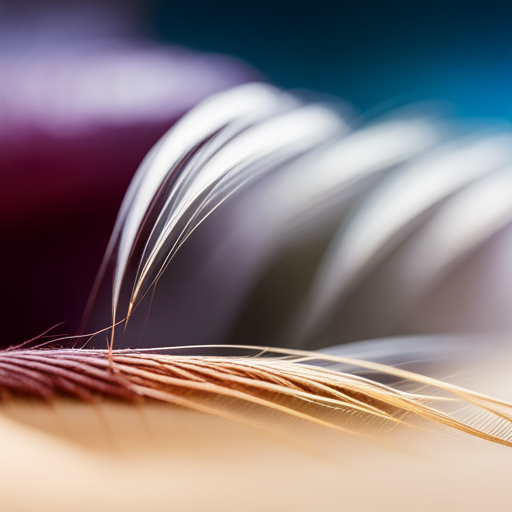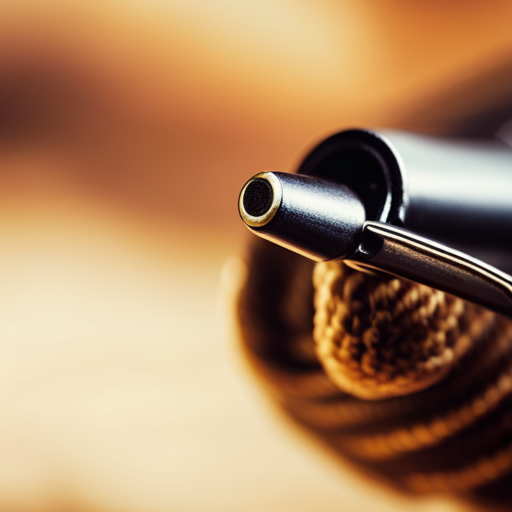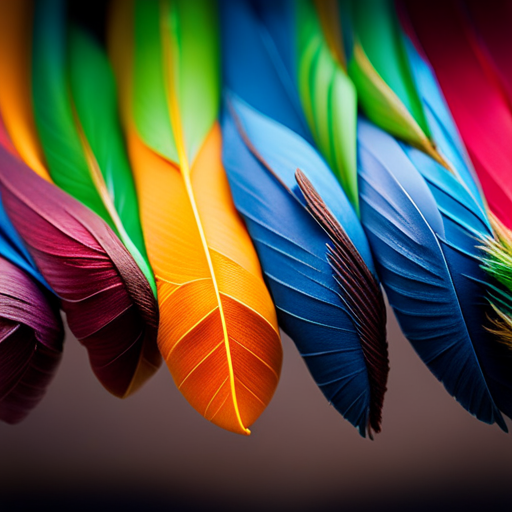Did you know that the type of hair used in fly tying can significantly impact the effectiveness of your flies?
In ‘The Essential Guide to Selecting Fly Tying Hair,’ we delve into the intricate world of fly tying materials.
From understanding different hair types to matching them with specific fly patterns, this comprehensive guide will equip you with the knowledge and skills to choose the ideal hair for your fly tying endeavors.
Understanding Different Types of Hair
When selecting fly tying hair, it is essential to understand the different types of hair available, as they each have unique qualities that can impact the effectiveness of the fly. Hair types comparison is crucial in making an informed decision.
Some common types of hair used for fly tying include deer hair, elk hair, squirrel tail, and synthetic hair. Deer hair is buoyant and commonly used for tying terrestrial patterns, while elk hair is hollow and provides excellent flotation, making it suitable for dry flies. Squirrel tail hair is fine and often used for nymph patterns. Synthetic hair, on the other hand, offers versatility and can mimic the properties of natural hair while being more durable.
When it comes to hair selection tips, it is important to consider the pattern being tied and the desired properties of the fly. For instance, for a pattern that requires buoyancy, deer or elk hair may be the preferred choice. Understanding the characteristics of each type of hair and how they align with the intended purpose of the fly pattern is crucial for successful fly tying.
Additionally, considering the color, length, and texture of the hair is essential in achieving the desired aesthetic and functional outcome.
Characteristics of Ideal Fly Tying Hair
Understanding the essential characteristics of ideal fly tying hair is crucial for achieving successful fly patterns. When it comes to hair selection, tying techniques, and fly design, the following key characteristics should be considered:
-
Texture: The texture of fly tying hair greatly affects its ability to be manipulated and shaped. Hair with the right texture ensures that it can be easily tied onto the hook and provides the desired silhouette for the fly pattern.
-
Length: The length of the hair is important in determining its usability for specific fly patterns. Longer hair may be suitable for creating streamers or larger flies, while shorter hair is ideal for smaller patterns and delicate designs.
-
Strength: The strength of the hair is essential for withstanding the tension and stress applied during the tying process. Strong hair ensures that the fly pattern remains intact and durable, even after multiple casts and retrieves.
-
Natural Movement: The natural movement of the hair in water is crucial for imitating the natural movement of prey. Hair with the right characteristics will impart lifelike motion to the fly, making it more appealing to target species.
Matching Hair to Fly Patterns
To effectively match hair to specific fly patterns, it is important to consider the intended characteristics and behavior of the fly in its targeted environment. Hair color plays a crucial role in pattern matching, as it should closely resemble the natural color of the insects or baitfish the fly is imitating. For example, for patterns mimicking mayflies, light dun, olive, or brown hair may be suitable, while darker hair colors such as black or brown may be more appropriate for imitating caddisflies or stoneflies.
Additionally, considering the texture of the hair is essential to replicate the natural appearance of the fly. For instance, deer hair with fine, hollow fibers is often preferred for dry flies, while patterns requiring more buoyancy, such as emergers or floating nymphs, may benefit from using materials with air-trapping properties.
Furthermore, the length of the hair should match the desired profile of the fly pattern. Longer hair may be suitable for creating extended body profiles, while shorter hair can be used for wings or tails. Understanding these considerations and selecting hair that aligns with the specific pattern requirements is fundamental to effectively matching hair to fly patterns.
Natural Vs. Synthetic Hair Options
When considering the choice between natural and synthetic hair options for fly tying, it is crucial to compare their material properties, such as texture, buoyancy, and color retention.
Additionally, evaluating the suitability of each hair type for specific fly patterns is essential for achieving desired fishing results.
Lastly, understanding the maintenance and durability differences between natural and synthetic hair will aid in making an informed decision about which option best meets the needs of the fly tyer.
Material Properties Comparison
Comparing the material properties of natural and synthetic hair options is essential for determining their suitability for fly tying. When it comes to fly tying, the properties of the hair used can significantly impact the effectiveness of the fly. Here’s a comparison of the material properties of natural and synthetic hair options:
-
Comparing hair flexibility: Natural hair often offers better flexibility, allowing for more lifelike movement in the water, while synthetic hair may be stiffer and less responsive to water currents.
-
Comparing hair texture: Natural hair tends to have a more varied and complex texture, providing a more realistic appearance, whereas synthetic hair can sometimes appear uniform and less natural.
-
Durability: Synthetic hair is often more durable and resistant to wear and tear compared to natural hair, which can be more prone to breakage.
-
Color range: Synthetic hair often offers a wider range of vibrant and consistent colors, while natural hair colors may vary and be more subdued.
Suitability for Fly Patterns
The suitability of natural and synthetic hair options for various fly patterns can significantly impact the appearance and effectiveness of the flies, particularly in terms of their movement and lifelike presentation in the water. When considering natural hair options, factors such as hair texture, color, length, and thickness play a crucial role in determining their suitability for specific fly patterns.
Natural hair, such as deer hair or elk hair, often provides a more realistic appearance and natural movement in the water due to its unique texture and color variations.
On the other hand, synthetic hair options offer a wide range of colors, lengths, and thicknesses, allowing fly tyers to create precise imitations of various insects or baitfish.
Understanding the characteristics of both natural and synthetic hair options is essential in selecting the most suitable material for specific fly patterns.
Maintenance and Durability
- Natural and synthetic hair options differ significantly in their maintenance and durability, impacting their longevity and performance in fly tying.
When it comes to hair care, natural materials such as deer hair require more attention to maintain their natural oils and prevent brittleness. On the other hand, synthetic materials are generally more resilient and easier to maintain, requiring minimal upkeep for long-lasting performance.
To ensure longevity, proper storage is crucial. Natural hair should be stored away from direct sunlight and moisture, while synthetic hair should be kept in a cool, dry place to prevent degradation.
Regular cleaning is essential for both natural and synthetic hair options. Use gentle shampoo and conditioner for natural hair and mild soap for synthetic hair to remove dirt and oils, preserving their quality for extended use.
Hair Preparation Techniques
To prepare fly tying hair effectively, it is crucial to employ proper techniques that ensure the optimal usability and appearance of the hair for fly tying.
Proper cleaning is essential to remove any dirt, oils, or residues that may affect the hair’s ability to hold onto the hook or interfere with the tying process. Before using the hair for tying, it should be thoroughly washed with a mild detergent to ensure cleanliness.
Additionally, hair dyeing techniques can be employed to customize the color of the hair to match specific fly patterns. Whether using natural or synthetic hair, dyeing techniques can be used to achieve desired colors, enhancing the visual appeal of the flies. When dyeing hair, it is important to follow the manufacturer’s instructions for the dyeing process to prevent damage to the hair fibers.
Evaluating Hair Quality
Assessing hair quality is a crucial step in selecting the most suitable material for fly tying. When evaluating hair for fly tying, there are several key factors to consider:
-
Texture: The texture of the hair is essential for creating durable and lifelike fly patterns. Look for hair that is smooth, fine, and has good elasticity. This will ensure that the hair is easy to work with and will result in flies that have a natural appearance and movement in the water.
-
Color Consistency: Consistency in color is important for achieving uniformity in the appearance of your flies. Choose hair with consistent coloration throughout the entire length of the hair. This will help you avoid variations in color that can detract from the overall aesthetic of your fly patterns.
-
Strength and Flexibility: Opt for hair that is strong and flexible, as these qualities will make the material easier to work with and will contribute to the durability of your flies.
-
Natural Oils and Shine: Look for hair that has natural oils and a healthy shine, as this indicates the overall health and quality of the hair, and will enhance the attractiveness of your fly patterns.
Specialty Hair for Specific Fly Types
When selecting specialty hair for specific fly types, it is important to consider the unique characteristics that will best complement the intended fly patterns. Fly tying techniques and hair selection go hand in hand, as different types of flies require specific hair qualities to achieve the desired results.
For example, when tying dry flies, such as mayflies or caddisflies, using hair with natural buoyancy like deer hair or elk hair is essential to keep the fly floating on the water’s surface.
On the other hand, for streamer patterns designed to imitate baitfish, using long, soft hair like rabbit strips or synthetic materials can help create lifelike movement in the water.
Additionally, for saltwater flies, durable and water-resistant hair like bucktail or synthetic fibers are ideal to withstand the harsh saltwater environment.
Understanding the unique characteristics of different fly patterns and the corresponding specialty hair needed is crucial for successful fly tying. By selecting the right hair for specific fly types, fly tyers can enhance the effectiveness and realism of their patterns.
Sourcing and Storing Fly Tying Hair
Acquiring and maintaining a well-organized inventory of fly tying hair is essential for efficient and effective fly tying. When it comes to sourcing and storing fly tying hair, there are several options and techniques to consider:
-
Local Fly Shops: Building a relationship with a local fly shop can provide access to a variety of high-quality fly tying hair. It also allows for a hands-on selection process, ensuring you get exactly what you need for your fly patterns.
-
Online Retailers: The internet offers a vast array of options for purchasing fly tying hair. Online retailers provide convenience and access to a wide range of hair types and colors, often with detailed product descriptions to aid in decision-making.
-
Trade Shows and Events: Attending fly fishing and fly tying expos or events can offer unique sourcing opportunities. These gatherings often feature vendors with specialty materials and hard-to-find hair types.
-
Proper Storage Techniques: To maintain the quality of fly tying hair, it should be stored in a cool, dry place away from direct sunlight. Utilizing airtight containers or resealable bags can help prevent moisture and pests from compromising the hair.
Frequently Asked Questions
Can I Use Hair From My Own Pet for Fly Tying?
When considering using pet hair for fly tying, it’s important to explore ethical alternatives. Personal collection or sustainable sourcing are better options. It’s crucial to make choices that align with responsible and environmentally conscious practices.
Are There Any Ethical or Environmental Concerns Related to Sourcing Fly Tying Hair?
When considering ethical and environmental concerns related to sourcing fly tying hair, it’s important to prioritize animal welfare and sustainability. Conservation and responsible sourcing are paramount, ensuring that the materials used align with ethical and environmental standards.
How Can I Maintain the Quality of My Fly Tying Hair Over Time?
Preserving the quality of fly tying hair over time requires proper maintenance and storage methods. To ensure longevity, store the hair in a cool, dry place and avoid exposing it to sunlight or moisture. Regular hair care maintenance is essential.
Are There Any Specific Regulations or Restrictions on Using Certain Types of Animal Hair for Fly Tying?
Regulations regarding the use of animal hair in fly tying vary by region and species. It’s important to consider animal welfare, source, and sustainability when selecting materials. Check local wildlife and conservation authorities for specific restrictions.
What Are Some Creative Ways to Use Specialty Hair for Unique Fly Patterns?
Innovative fly patterns can be achieved by creatively incorporating specialty materials such as exotic animal hair or synthetic fibers. This can result in unique designs that attract different fish species, making for a more versatile and engaging fly tying experience.
Conclusion
In conclusion, selecting the right fly tying hair is essential for creating effective and realistic fly patterns. By understanding the different types of hair, their characteristics, and how to match them to specific fly patterns, fly tyers can produce high-quality flies.
Whether choosing natural or synthetic hair, proper preparation and evaluation of hair quality are crucial. Remember, the right hair can make or break a fly pattern, so choose wisely and store it carefully.




